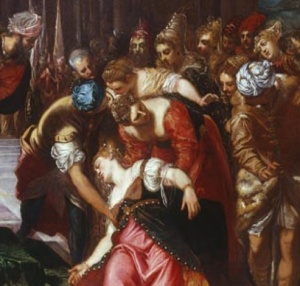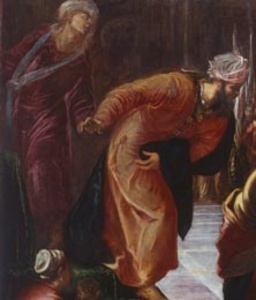Esther’s Swoon Revealed
Earlier this summer I went up to the Boston Museum of Fine Arts to see the blockbuster exhibition, Titian, Tintoretto, Veronese: Rivals in Renaissance Venice. While rarely have I seen as many masterpieces collected together in a traveling show, one painting stood out for both its Jewish subject and the surprising way it narrated the dramatic story of Esther appearing before Ahasuerus.

The painting, Esther Before Ahasuerus is by Tintoretto, (1518-1594) was painted just as the 29 year old artist was making his mark in Venetian society.

I have written briefly about this work in the Jewish Press (“Esther in Venice,” March 2008) but that was to superficially comment on the “swoon” motif that dominated late Renaissance depictions of this episode. As I explained: “The artworks show Esther approaching the King, violating the ban on anyone approaching the King unless summoned. In painting after painting it is the salient episode in the narrative that the artist and patron have determined is of crucial importance…. In some depictions she bows and the King extends his royal scepter to permit and acknowledge her presence. More frequently she is seen swooning into the arms of her female assistants, eliciting compassion in the King who rushes to her aid. While this episode is not found in our Hebrew text, a version is seen in the Midrash Rabba and in the Catholic version of the story that contains an addition called the Greek Esther.”
Upon viewing this large (almost 7’ X 9’) expertly restored painting many unexpected elements revealed themselves. What is most exciting is to see how the artist manipulated the narrative, effectively expanding a simple description so that the underlying dynamic of the event is revealed.

This version of the episode relates that Ahasuerus “looked at her, blazing with anger. The queen sank down. She grew faint… But God changed the king’s heart… He sprang from his throne in alarm… comforting her with soothing words.” The entire event, while heartfelt, was a brilliant performance on Esther’s part calculated to manipulate the king into attending her own banquet so that she could out-maneuver Haman and his plot of annihilating the Jews. What Tintoretto has created is torrent of motion precipitated by Esther’s swoon that sweeps through the painting charting his own insights.
In a curious way the visual narrative begins with the bright blue hat smack in the center belonging to the man reaching down to support the limp Esther. The downward arc of his arm leads our eye across her figure as our gaze sweeps diagonally across and up to the excited crowd of royal maidens and assistants that form a great circle of heads around the stricken heroine. These maidens constitute an audience of concerned faces that reinforces our sense of the urgent drama that is unfolding, effectively making us also an audience to her fainting spell.
This swirling motion dominates the right side of painting, creating a gravitational pull on King Ahasuerus. As if propelled by her downward collapse, the king is drawn up out of his unseen throne. A companion of mine, critic Tom Freudenheim, commented that the king appeared dangerously off balance as he leaned out over the steps that lead to his throne. This is emphasized by the dark robe that sweeps along his arm into his waist, effectively undercutting his golden robe. If he would hesitate one moment longer he would surely fall forward in a royal heap.
By following Tintoretto’s visual cues we are directed to the heart of the painting’s meaning. In the earlier part of the story King Ahasuerus is overwhelmingly static, a royal power who is manipulated by the evil Haman to acquiesce in the coming holocaust. Esther, through her dramatic entrance and collapse, wrenches him from his complacency, literally pulling him off his throne, off balance as he rushes to his fainting queen. It is by following the flow of the painting, whipped around the seemingly helpless Esther and ending in the off balance king that we realize the object of Esther’s drama. She must make the king act, he must be shaken out of his stupor and become an agent in saving the Jewish people.
In savoring the skill with which the artist unraveled the narrative, dramatically carrying it forward, I noticed one small detail that suddenly changed everything. Standing right behind the king was a mysterious figure in a deep crimson robe. His head was bent back revealing only an ugly face, thick lips and bulging eyes, seemingly a figure in pain or agony. His arm stretches forward, appearing to meet or join with the king’s outstretched hand. If you looked carefully you could imagine that they were practically holding hands. Could he be anyone other than the evil Haman?
The more I looked the more the figure made a terrible kind of sense. He was figuratively holding the king’s hand, if only by juxtaposition, because they were in fact up to that moment partners in a plot against the Jews. It makes sense that he would be close to the king in the court and certainly Esther’s claim on the king’s emotions would compete with Haman’s primacy. Finally, he was wearing some kind of scarf, wrapped around his neck and loosely knotted at waist level, a grim foreshadowing of Haman’s ultimate fate upon the gallows. By resolutely leading our eyes to the upper left corner of the painting Tintoretto was telling his viewers that Esther’s performance that fateful day was not only directed as arousing the king’s empathy and concern but the ultimate goal was to uproot and destroy the wicked Haman. And isn’t that the entire point of Megillas Esther? It seems Jacopo Robusti, called Tintoretto, got it right.